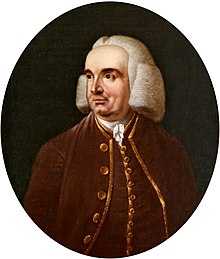
Freemasonry or Masonry refers to fraternal organisations guilds of stonemasons that, from the end of the 14th century, regulated the qualifications of stonemasons and their interaction with authorities and clients. Modern Freemasonry broadly consists of two main recognition groups: Regular Freemasonry, which insists that a volume of scripture be open in a working lodge, that every member professes belief in a Supreme Being, that no women be admitted, and that the discussion of religion and politics do not take place within the lodge; and Continental Freemasonry, which consists of the jurisdictions that have removed some, or all, of these restrictions.
The history of Freemasonry encompasses the origins, evolution and defining events of the fraternal organisation known as Freemasonry. It covers three phases. Firstly, the emergence of organised lodges of operative masons during the Middle Ages, then the admission of lay members as "accepted" or "speculative" masons, and finally the evolution of purely speculative lodges, and the emergence of Grand Lodges to govern them. The watershed in this process is generally taken to be the formation of the first Grand Lodge in London in 1717. The two difficulties facing historians are the paucity of written material, even down to the 19th century, and the misinformation generated by masons and non-masons alike from the earliest years.

William Preston was a Scottish author, editor and lecturer, born in Edinburgh. After attending school and college he became secretary to the linguist Thomas Ruddiman, who became his guardian on the death of his father. On the death of Thomas, Preston became a printer for Walter Ruddiman, Thomas' brother. In 1760 he moved to London and started a distinguished career with the printer William Strahan. He became a Freemason, instituting a system of lectures of instruction, and publishing Illustrations of Masonry, which ran to several editions. It was under Preston that the Lodge of Antiquity seceded from the Moderns Grand Lodge to become "The Grand Lodge of All England South of the River Trent" for ten years. He died on 1 April 1818, after a long illness, and was buried in St Paul's Cathedral.
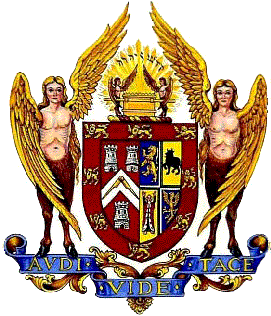
The United Grand Lodge of England (UGLE) is the governing Masonic lodge for the majority of freemasons in England, Wales, and the Commonwealth of Nations. Claiming descent from the Masonic Grand Lodge formed 24 June 1717 at the Goose & Gridiron Tavern in London, it is considered to be the oldest Masonic Grand Lodge in the world, together with the Grand Lodge of Scotland, and the Grand Lodge of Ireland.

The Grand Lodge of Ireland is the second most senior Grand Lodge of Freemasons in the world, and the oldest in continuous existence. Since no specific record of its foundation exists, 1725 is the year celebrated in Grand Lodge anniversaries, as the oldest reference to Grand Lodge of Ireland comes from the Dublin Weekly Journal of 26 June 1725. This describes a meeting of the Grand Lodge to install the new Grand Master, The 1st Earl of Rosse, on 24 June. The Grand Lodge has regular Masonic jurisdiction over 13 Provincial Grand Lodges covering all the Freemasons of the island of Ireland, and another 11 provinces worldwide.

Freemasonry in Malta has a lengthy history dating from the eighteenth century. The main masonic influences have been from the United Grand Lodge of England, the Grand Lodge of Scotland, and the Grand Lodge of Ireland. Today Regular Freemasonry is under the jurisdiction of the Sovereign Grand Lodge of Malta, formed in 2004.
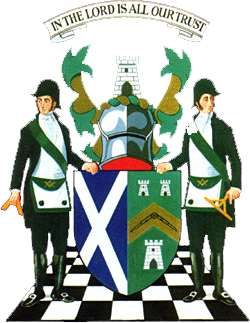
The Grand Lodge of Antient Free and Accepted Masons of Scotland is the governing body of Freemasonry in Scotland. It was founded in 1736. About one third of Scotland's lodges were represented at the foundation meeting of the Grand Lodge.
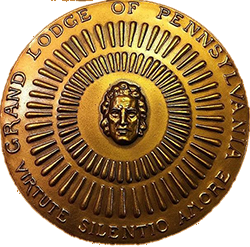
The Grand Lodge of Pennsylvania, officially The Right Worshipful Grand Lodge of the Most Ancient and Honorable Fraternity of Free and Accepted Masons of Pennsylvania and Masonic Jurisdictions Thereunto Belonging, sometimes referred to as Freemasons of Pennsylvania is the premier masonic organization in the Commonwealth of Pennsylvania. The Grand Lodge claims to be the oldest in the United States, and the third oldest in the world after England and Ireland, having been originally established as the Provincial Grand Lodge of Pennsylvania in 1731. This claim is disputed by both the Grand Lodge of Massachusetts and the Grand Lodge of Virginia.
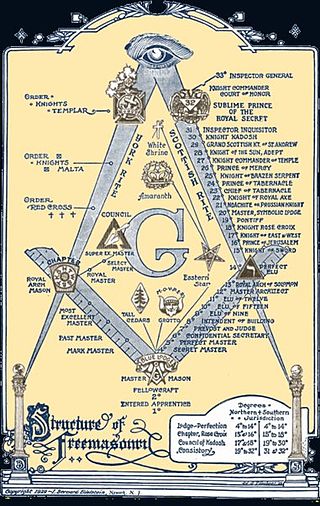
There are many organisations and orders which form part of the widespread fraternity of Freemasonry, each having its own structure and terminology. Collectively these may be referred to as Masonic bodies, Masonic orders, Concordant bodies or appendant bodies of Freemasonry.
There are a number of masonic manuscripts that are important in the study of the emergence of Freemasonry. Most numerous are the Old Charges or Constitutions. These documents outlined a "history" of masonry, tracing its origins to a biblical or classical root, followed by the regulations of the organisation, and the responsibilities of its different grades. More rare are old hand-written copies of ritual, affording a limited understanding of early masonic rites. All of those which pre-date the formation of Grand Lodges are found in Scotland and Ireland, and show such similarity that the Irish rituals are usually assumed to be of Scottish origin. The earliest Minutes of lodges formed before the first Grand Lodge are also located in Scotland. Early records of the first Grand Lodge in 1717 allow an elementary understanding of the immediate pre-Grand Lodge era and some insight into the personalities and events that shaped early-18th-century Freemasonry in Britain.

The Ancient Grand Lodge of England, as it is known today, or The Grand Lodge of the Most Ancient and Honourable Fraternity of Free and Accepted Masons as they described themselves on their warrants, was a rival Grand Lodge to the Premier Grand Lodge of England. It existed from 1751 until 1813 when the United Grand Lodge of England was created from the two Grand Lodges. They are now called the Antients, in contrast to the Moderns, the original Grand Lodge which its critics, notably Laurence Dermott, said had moved away from the ritual of Scotland, Ireland, and now the Antient Grand Lodge. This Grand Lodge was also informally called the Atholl Grand Lodge because the Third and Fourth Dukes of Atholl presided over it as Grand Masters for half of its 62-year existence.

The organisation now known as the Premier Grand Lodge of England was founded on 24 June 1717 as the Grand Lodge of London and Westminster. Originally concerned with the practice of Freemasonry in London and Westminster, it soon became known as the Grand Lodge of England. Because it was the first Masonic Grand Lodge to be created, modern convention now calls it the Premier Grand Lodge of England in order to distinguish it from the Most Ancient and Honourable Society of Free and Accepted Masons according to the Old Constitutions, usually referred to as the Ancient Grand Lodge of England, and the Grand Lodge of All England Meeting at York. It existed until 1813, when it united with the Ancient Grand Lodge of England to create the United Grand Lodge of England.

This is a chronology of the formation of "regular" or "mainstream" Masonic Grand Lodges in North America, descending from the Premier Grand Lodge of England or its rival, the Antient Grand Lodge of England. A Grand Lodge is the governing body that supervises "Craft" Freemasonry in a particular jurisdiction or geographical area.
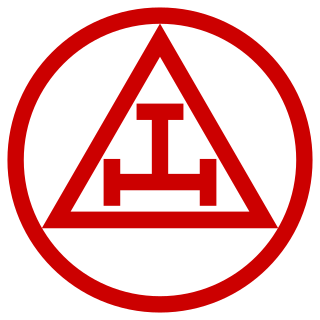
The Royal Arch is a degree of Freemasonry. The Royal Arch is present in all main masonic systems, though in some it is worked as part of Craft ('mainstream') Freemasonry, and in others in an appendant ('additional') order. Royal Arch Masons meet as a Chapter; in the Supreme Order of the Royal Arch as practised in the British Isles, much of Europe and the Commonwealth, Chapters confer the single degree of Royal Arch Mason.

Royal Arch Masonry is the first part of the American York Rite system of Masonic degrees. Royal Arch Masons meet as a Chapter, and the Royal Arch Chapter confers four degrees: Mark Master Mason, Past Master, Most Excellent Master, and Royal Arch Mason.

Masonic ritual is the scripted words and actions that are spoken or performed during the degree work in a Masonic lodge. Masonic symbolism is that which is used to illustrate the principles which Freemasonry espouses. Masonic ritual has appeared in a number of contexts within literature including in "The Man Who Would Be King", by Rudyard Kipling, and War and Peace, by Leo Tolstoy.

Thomas Smith Webb was the author of Freemason’s Monitor or Illustrations of Masonry, a book which had a significant impact on the development of Masonic Ritual in America, and especially that of the York Rite. Webb has been called the "Founding Father of the York or American Rite" for his efforts to promote those Masonic bodies.
Freemasonry or Masonry refers to a civic movement promoting fraternity and good works. Freemasonry defines itself as “a regular system of morality, veiled in allegory and illustrated by symbols.” In particular masonic meetings are characterized by initiations and rituals. As such masonry has been viewed historically by churches and governments as secret societies.
Freemasonry in Spain is first recorded in 1728, in an English lodge. As various papal bulls condemned Freemasonry the Spanish Inquisition did their best to close lodges and demonise Freemasons, therefore the success of Freemasonry from year to year depended on the sympathy or antipathy of the ruling regime. Nevertheless, lodges and even Grand Lodges were formed, and even thrived during more liberal periods. When Francisco Franco consolidated power in 1939, all Freemasonry was banned. In 1979, four years after Franco's death, bans on Freemasonry were declared unconstitutional, and several Grand Lodges and Orients now flourish in Spain.
Operative Masonry or The Worshipful Society of Free Masons, Rough Masons, Wallers, Slaters, Paviors, Plaisterers and Bricklayers or simply The Operatives is a fraternal guild claiming a history of hundreds of years over which customs, traditions, knowledge and practices were developed and handed down. It is an invitation only, Masonic society dedicated to preserving the history, rituals, and traditions of medieval operative stonemasons guilds in England and Europe that were the precursors to modern speculative Freemasonry.

